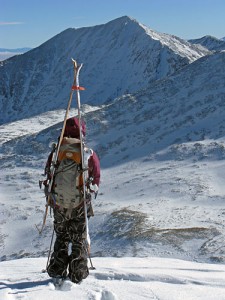Date: Nov. 1, 2009
Team: Christy, Ted
Route: East Face
Shhh. Maybe this time if we’re really quiet they won’t notice us…. Nope.
We recently skied Clinton Peak, 13,857 feet, which was Christy’s 99th summit of the Colorado Centennials. Now all that remains is Gladstone Peak.
Because we regularly discuss similar sounding adventures and lists concerning 14ers, it may help to explain the Centennial Peaks list in greater depth. Simply put, if you compiled a list of the tallest peaks in the state, the 14ers would comprise the highest summits but would only get you to #54. If you add the next 46 peaks down the list, the highest of the 13ers, then you have the 100 tallest mountains in Colorado, a.k.a the Colorado Centennial Peaks or Colorado 100. To see the list, click here. With Christy as a regular partner, I finished climbing them in 2006 and now she is just one peak shy of finishing herself. Unlike the shorter 14ers list, the goal for the 100 is not to ski them but more simply just to summit. In the summer months we hike and in other seasons we ski. And to answer the next obvious question– no one has yet claimed to ski every peak on this list. No doubt some are thinking about it.
As for what the Colorado 100 entails, well the first and most obvious point might be that graduating from climbing the 14ers to the Centennials nearly doubles the length of the list which should make it nearly double the effort. In reality it feels like more. That’s because all peaks aren’t equal and in this case, many of the lesser peaks filling in the back end of the list present considerable challenges. It’s often incorrectly assumed that lower elevations translate into easier climbs– as an example think Everest vs. K2 (hint: the shorter K2 is a considerably harder mountain to climb).
Furthermore, not a single 14er requires the use of a rope by their easiest routes, yet several Centennial 13ers do, often in the form of mandatory rappels. Two of them that fit that description, Teakettle and Jagged Peak, sometimes even involve belayed climbing as well. More to the point, the agreed upon “hardest summit of the 100” is not Capitol Peak as many might guess- the most feared of the 14ers. It’s actually Dallas Peak, which measures in at a diminutive 13,809 feet. It’s the 100th tallest on the list and requires lead climbing and rappelling by its easiest route– it’s the most technical summit of the Colorado 100 yet it’s the shortest one. Go figure.

Also significant is the fact that a few of the high 13ers are, by Colorado standards, extremely remote. Jagged Peak and Rio Grande Pyramid are at least as deep in hills as the most hard-to-reach 14ers. But because the sub-14ers get only a fraction of the visitors when compared to their taller neighbors, they often have much less in the way of defined trails. When they do exist, they tend to fade in and out or head off in random directions because they’re often just game trails created by elk, bighorn sheep, or goats– none of whom are up there for the same reasons you are, thus explaining their randomness. For those reasons, even some of the shorter approaches to Centennial 13ers can be more arduous and time consuming than reaching a more remote 14er. Without a steady stream of peak baggers, the talus doesn’t get settled into a solid trail and loose rock isn’t cleaned off the upper routes either. You definitely won’t find the signature man-made rock staircases so plentiful on peaks higher than 14K thanks to the incredible efforts of the Colorado Fourteeners Initiative. Cairns are sparse, summit registers sparser and other climbers almost non existent.
But that last part is good, and a reason for doing the 100. Christy and I recall sitting alone on the summit of Ice Mountain on the 4th of July some years back and looking across the valley to neighboring Huron Peak, 14,003 feet. We could hear conversations and barking dogs amongst the near two dozen people visible on its summit. And again this past summer on the same holiday weekend we noticed a similar situation on Mount Elbert, while we stood alone on Casco and French Peaks. In fact we find when it comes to these Centennial 13ers, apart from a few goats which we’re always happy to see, we’re usually all alone. And that’s in the summer months. If you want a guaranteed day of solitude then go ski a Centennial 13er, I promise you’ll have it all to yourself.
So that’s what we had here on Clinton, another day just ourselves and some goats, though at first glance we weren’t sure if we had just discovered Colorado’s first polar bear (2nd from right, click to enlarge). Good Lord, look at the size of him. Not your typical lean, fit adult goat. Maybe instead of lazily following the young calf’s tiring hooftrack he should be breaking trail so he could shed a few pounds! One thing’s likely, he should be OK surviving the harsh winter.
We’ll make it down to Telluride sometime near spring to try for Gladstone and wrap this whole thing up.
But then what?






